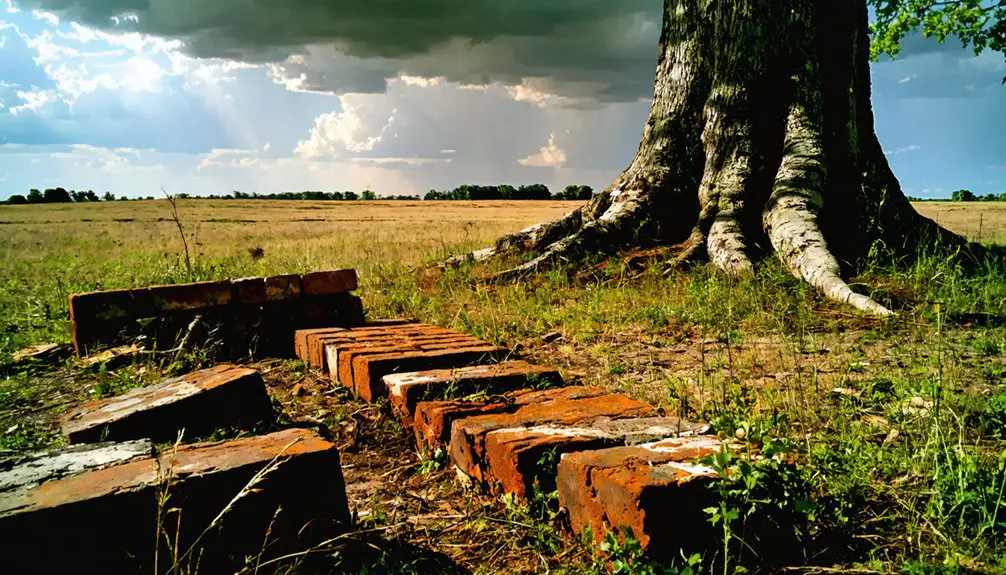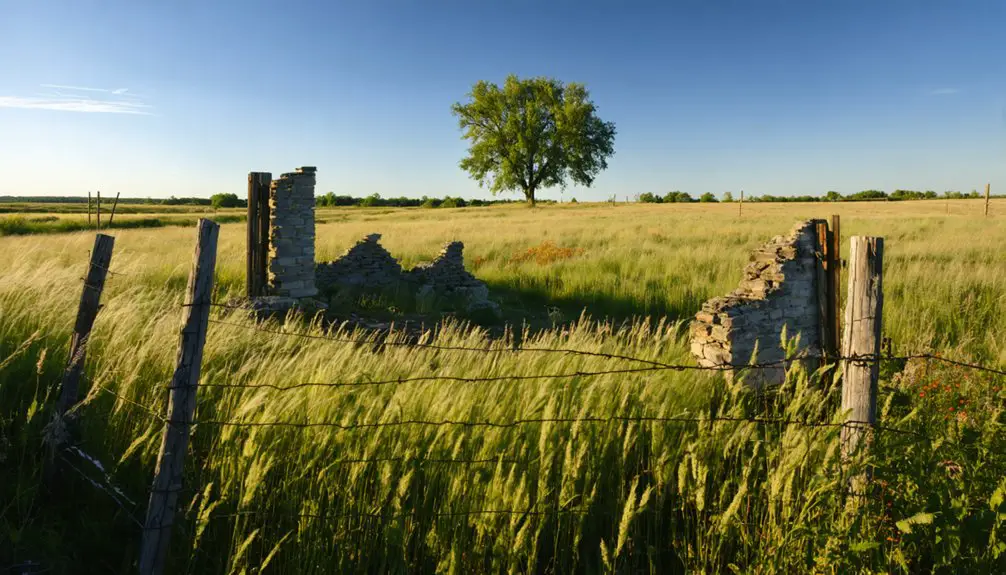Founded in 1856, you’ll discover Sumner City was once a thriving Free State settlement that peaked at 2,500 residents by 1858. The town served as an essential transport hub along the Santa Fe and Oregon Trail routes, with bustling trading posts and freight operations. After a devastating tornado in 1860 and shifting railroad lines, the settlement rapidly declined. Today, only a well-maintained family cemetery on 258 Road marks this fascinating piece of Kansas frontier history.
Key Takeaways
- Founded in 1856 as a Free State settlement, Sumner City grew to 2,500 residents and served as a vital transport hub.
- A devastating tornado in June 1860 destroyed most buildings, marking the beginning of the town’s decline.
- Railroad lines shifted away from Sumner City, causing businesses to relocate and residents to abandon the settlement.
- Only the family cemetery on 258 Road remains active today, with all other structures having vanished over time.
- The town’s legacy lives on through historical documentation, PBS documentaries, and local ghost stories about the last mayor’s spirit.
The Rise of a Pioneer Settlement
When Charles Sumner’s anti-slavery advocacy inspired Kansas settlers in 1856, they established Sumner City on the commanding bluffs overlooking the Missouri River. Pioneer motivations centered on creating a Free State stronghold, with Massachusetts settlers bringing their abolitionist ideals to this strategic location.
You’ll find that early governance took shape quickly as the community flourished. By 1857, they’d established a post office and begun construction of a $16,000 brick hotel, symbolizing the town’s prosperity and ambition. The Sumner Gazette newspaper began publishing local news and promoting the town’s growth in September 1857.
The bustling levee became a commercial hub, with steamboats delivering Pennsylvania lumber and other merchandise. The founders’ commitment to equality attracted diverse settlers, including African American families by 1870. By late 1858, the town reached its peak with 2,500 residents surpassing rival Atchison in population.
The river brought commerce and diversity, as Sumner’s welcoming shores drew settlers seeking both economic opportunity and racial equality.
Despite the rugged terrain’s challenges, Sumner’s pioneers built a thriving community united by their anti-slavery stance and determination for freedom.
Life Along the Westward Trail
As you traveled west through Sumner City in the 1850s, you’d find a bustling transport hub where pioneer traders exchanged goods and supplies along the intersecting Santa Fe and Oregon Trail routes.
You’d witness wagon trains stopping to replenish their provisions while steering through the harsh realities of frontier life, including disease outbreaks and resource scarcity that plagued many settlements. Pioneer groups often relied on buffalo chips as fuel since wood was scarce in the open prairie.
Your success in this emerging community would depend heavily on building relationships with fellow settlers and maintaining access to essential resources, as the town served as a critical waypoint for those pursuing westward dreams. The Santa Fe Trail opened in 1821, establishing the important trade route that would help shape Sumner City’s early development.
Pioneer Trading Activities
During the westward expansion of America, trading posts emerged as essential lifelines for pioneers traversing the frontier trails.
You’d find these dynamic hubs offering necessary supplies, repairs, and important information about trail conditions. Trading post dynamics revolved around meeting diverse pioneer needs through barter systems and sales of food staples, tools, and services like blacksmithing.
If you were traveling west, you’d rely heavily on these posts for everything from mule repairs to leather goods. Travelers would stock up on vital provisions like flour and bacon, which were among the most common supplies carried by wagon trains.
They weren’t just commerce centers – they served as information exchanges where you’d learn about Native American relations and trail hazards. As trail traffic increased to 50,000 people annually, trading posts became increasingly vital support centers.
The posts often grew into settlements, supporting a network of skilled artisans who provided wagon repairs and other essential services you’d need for survival on the frontier.
Transport Hub Operations
Located three miles south of Atchison, Kansas, Sumner City emerged as a vital transport hub that served thousands of pioneers heading west.
The town’s transport logistics revolved around massive oxen and mule teams that hauled freight across the Great American Desert toward the Rocky Mountains. At its peak, you’d find 2,500 residents managing the constant flow of goods and animals through the bustling streets. Similar to Hunnewell, Kansas, the town became a major shipping point with over 1,500 cattle loads moving through annually.
The freight challenges were significant, with seasonal threats like grasshopper plagues and tornadoes disrupting operations, as seen in 1860. Like many settlements of its era, the town’s fate was sealed when it was bypassed by railroads.
Despite these obstacles, Sumner City’s strategic location made it an indispensable relay point for westward expansion. The town buzzed with commerce as settlers gathered supplies, while saloons and warehouses catered to the thousands of travelers preparing for their journey west.
Daily Frontier Challenges
Pioneer life along the westward trail through Sumner City followed a demanding daily rhythm that tested even the hardiest travelers.
You’d start your journey at dawn, covering up to twenty miles on good days, with a brief rest at noon. The most perilous moments came during river crossings, where you risked losing supplies or even your life to treacherous waters. A typical day started with bugle or rifle shots at 4:00 AM to wake the camp.
Disease outbreaks could sweep through wagon trains without warning, and accidents from stampeding animals or overturned wagons were constant threats. Women and children often had to walk alongside wagons while men drove the teams forward.
You’d form wagon corrals by evening for protection, posting guards through the night. Despite these challenges, you’d find comfort in the strong bonds formed with fellow travelers, sharing evening meals and occasionally dancing to lift spirits after a grueling day on the trail.
Peak Years and Population Growth
The bustling frontier town of Sumner, Kansas achieved its zenith with approximately 2,500 residents in the late 19th century, emerging as an essential transportation hub in Atchison County.
Sumner’s rise as a vibrant frontier town transformed it into a crucial transportation center, drawing thousands to Kansas’s promising landscape.
You’d have found a diverse mix of pioneers, including families from various European backgrounds, all contributing to the town’s rapid growth. Population demographics reflected the era’s immigrant influx, while economic factors centered on trade and transport operations.
- Thousands of oxen and mules moved through daily, driving commerce
- Pioneer families from Irish, German, Scottish, and Swiss descent shaped the community
- Multiple age groups created a balanced population structure
- Transportation and trade workers formed the economic backbone
- Early settlers established the town before 1870, sparking quick development
Natural Disasters Strike

Despite Sumner City’s promising growth, nature released a devastating series of blows that would forever alter the town’s trajectory. In June 1860, a tornado ravaged the settlement, destroying or damaging nearly every building.
Before the community could recover, a grasshopper plague struck in September, decimating crops and deepening the economic crisis.
The natural disasters proved too overwhelming for this fledgling town. As residents abandoned their damaged properties, nature began its ecological reclamation. Rains and snow gradually filled foundation holes, while forests of oak and cottonwood reclaimed the once-bustling streets.
The final act came when lightning struck the last inhabited cabin, burning it to the ground. Today, you’ll find no trace of Sumner City beneath the thick undergrowth that’s completely transformed the former townsite.
The Town’s Swift Disappearance
Once railroad lines shifted away from Sumner City in favor of neighboring towns, the settlement’s vital role as a transportation hub quickly unraveled.
The economic factors that had sustained the town’s prosperity vanished as trade routes changed. Population trends show a dramatic exodus from the once-thriving community of 2,500 residents, leaving behind empty streets and abandoned buildings.
Once home to 2,500 hopeful residents, Sumner City’s streets emptied as changing trade routes stripped away its economic foundation.
- Businesses and merchants relocated to towns with stronger railroad connections
- Schools and social institutions closed as families sought opportunities elsewhere
- Postal services diminished, further isolating remaining residents
- Neighboring towns like Atchison attracted settlers with better infrastructure
- Lack of economic diversification left no foundation for recovery
You can trace the town’s swift transformation into a ghost town through the closure of essential services and the rapid departure of its community members, marking the end of Sumner City’s brief but significant role in Kansas history.
Historical Impact on Atchison County

While Sumner City’s physical presence in Atchison County proved short-lived, its establishment and decline profoundly shaped the region’s political and social landscape during Kansas’ territorial period.
Founded on strong abolitionist principles, you’ll find that Sumner’s emergence created intense political rivalry with pro-slavery Atchison, reflecting the larger tensions of Bleeding Kansas.
The town’s Massachusetts settlers actively pushed for political influence, with founder John P. Wheeler leading efforts to secure the county seat designation.
Though Sumner ultimately failed in its bid for county dominance, its Free State ideology influenced settlement patterns and governance throughout the region.
The competition between Sumner and Atchison reshaped how resources and populations consolidated, leaving a lasting impact on the county’s development even after the town’s abandonment.
Preserving Sumner City’s Memory
Although Sumner City’s physical structures have vanished into history, dedicated efforts preserve its memory through multiple channels.
Today, you’ll find the town’s cultural memory lives on through documented research, local ghost stories, and educational programs that keep its legacy alive for future generations.
- The family cemetery on 258 Road remains active and well-maintained, serving as a tangible link to the past.
- Local folklore features the ghost of Sumner’s last mayor, who’s said to search endlessly for former residents.
- PBS documentaries showcase Sumner among other ghost towns, bringing its story to wider audiences.
- Multiple historical sources document the town’s rise and fall through land records and newspaper accounts.
- Online articles and videos make historical information readily accessible to curious researchers and history buffs.
Frequently Asked Questions
What Artifacts Have Been Recovered From the Sumner City Site?
You’ll find recovered artifacts spanning industrial materials, domestic items, transportation relics, and prehistoric objects. Recovery methods revealed their historical significance through excavations of lumber mill remnants, railroad equipment, and household materials.
Were There Any Native American Settlements in the Area Before Sumner City?
While specific Native Tribes didn’t have permanent settlements at Sumner City’s exact location, you’ll find Historical Significance in the area’s past as part of the Diminished Osage Reserve and Cherokee hunting grounds.
What Happened to the Residents After They Left Sumner City?
You’ll find former residents scattered north to Atchison, settled in railway towns like Hunnewell and Rome, or moved to urban centers. Some joined cattle operations while others pursued farming in neighboring communities.
Did Any Buildings or Structures From Sumner City Survive Until Today?
Like a town that vanished into thin air, you’ll find no architectural remnants except the Sumner Cemetery. Historical preservation wasn’t possible since all buildings were dismantled or moved by 1873.
Were There Any Famous Visitors to Sumner City During Its Existence?
You won’t find records of famous visitors to the town, though several young residents later achieved historical significance. The town’s location on pioneer trails likely drew notable traders and transporters.
References
- https://legendsofkansas.com/sumner-kansas/
- https://theactiveage.com/these-kansas-towns-didnt-stand-a-ghost-of-chance/
- https://www.legendsofamerica.com/hunnewell-kansas/
- https://www.sumnernewscow.com/four-sumner-county-ghost-towns-will-be-featured-on-pbs-documentary-tonight/
- https://www.youtube.com/watch?v=OyBXD18P_j4
- https://alincolnguide.com/sumner-info/
- https://sites.rootsweb.com/~kssumnhp/history/earliestsettlers.html
- http://www.kancoll.org/books/cutler/sumner/sumner-co-p1.html
- https://ctmuseumks.com/blog/sumner-city-the-city-that-almost-was
- https://legendsofkansas.com/first-kansas-settlements/



